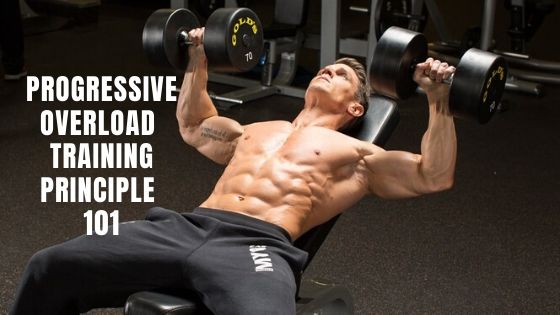If you want to learn about progressive overload and how you can implement this principle in your training routine – then you need to read this article.
To get maximum strength and muscle building results you have to use this principle correctly. So let’s get started.
What Is Progressive Overload Principle
The worst mistake you can do is doing the same thing over and over in the gym and expecting different results.
One of my gym members comes regularly in the gym and does that same full-body workout with the same sets, reps, and weights. And obviously, his body never changes.
If you want to grow your muscles bigger and stronger, you have to challenge your body. Your body won’t change unless you force it to change. And that’s where the principle of progressive overloading comes into play.
Definition: Progressive overload is a method in which you gradually increase the stress applied to your muscles during training.
The progressive overload principle is not limited to weight lifting or strength training only. You can apply it to cardiovascular training and endurance training also.
There are several ways to use this. I’ll explain them later in the article.
Why Is Progressive Overload Important
If you don’t overload your muscles by giving them something more than what they’are used to, then they have no reason to grow. And you won’t be able to make gains.
No matter how disciplined you are with your training, how well-balanced diet you are taking, if you are not applying the principle of progressive overloading you won’t grow.
This involves gradually and continually increasing the stress on your musculoskeletal system. It is essential to gain muscle mass, increasing muscular strength, and endurance.
How Do You Do Progressive Overload
Here are the 4 ways to apply progressive overload principle effectively:
Increase Weights
This may be the most obvious way to increase stress on your muscles. Lifting a slightly heavier than your muscles are used to, give them a reason to grow.
It basically works like that –
Stimulus > Recovery > Adaptation
You don’t need to increase weight in every workout as muscles take time to adapt to that heavier load.
For example, when you can easily do 10-12 reps of bicep curls with 20 lb dumbbell, go on to 25 lb dumbbell. Your reps will reduce but that’s okay. When you’ll get stronger to lift that weight for more reps, repeat this cycle again.
Make sure to not go beyond the hypertrophy rep range (6-12). Choose a weight with which you can do at least 6 reps easily.
Note: Remember, increase only that much weight with which you can maintain proper form. Never compromise your form in the greed of lifting heavier.
Increase sets
This is another way of increasing training volume for progressive overloading. By increasing the total number of sets in a workout, you are making greater demands on your muscles.
This can be done in two ways. Either by doing one more set for the existing exercises or by doing more exercises.
Since your reps are limited in the hypertrophy range, so the weight you’re lifting won’t increase dramatically. So increasing total sets is the best way of increasing training volume.
Increase Reps
Increasing the number of reps within the hypertrophy limit is another way of using progressive overload principle. As, a 100 lb bench press for 12 reps is better than the 100 lb bench press for only 8 reps.
Remember, to maximize your muscle-building results, it is important to finish your sets in 8 to 12 rep range. Going beyond that would increase your muscular endurance and won’t give that much muscle-building benefits.
Increase training frequency
Training frequency is the number of times you train a muscle group in a week. Increasing the frequency of your training can increase the overload.
The traditional approach is to train one muscle per workout and training each muscle once a week. But training them more frequently may give you better muscle-building results.
Try to train each muscle twice a week. You can also use this technique to target a weak or lagging body part.
Reduce rest between sets
One more way to apply progressive overload principle is by reducing your rest periods. By reducing rest in-between the sets, you’ll end up doing the same amount of work in less time.
However, this method is more beneficial for endurance athletes or people who want to improve their muscular endurance.
How Often Should You Progressive Overload
Now this doesn’t mean you have to do progressive overload in every workout. It is not possible for your muscles to adapt in a single workout by that greater stimulus.
When you should apply progressive overload principle in your training, depends on multiple factors and varies individually. There’s no fixed answer to this question.
Here are some points you should consider before increasing the load-
Never compromise with the form: Whenever you increase weights, make sure you are able to lift that weight with proper form. Otherwise, it may lead to serious injuries.
Go for at least 6 reps: Don’t choose a weight which you can’t lift properly for even 6 reps. However, if you are a powerlifter, then it’s a different thing.
Choose according to your goal: You have to prioritize your training according to your fitness goals.
Methods like increasing weights or sets (total training volume) and training frequency are important for bodybuilders. While reducing the rest between sets and increasing reps (above 12) would be more beneficial for endurance athletes.
One method at a time: You can apply any of the above methods in your workout routine according to your goals. The best strategy would be to focus on one method at a time.
As muscles need time to adapt, hence applying multiple methods simultaneously will not be feasible.
In A Nutshell
So this was a detailed article explaining the progressive overload training principle including its importance and methods.
Progressive overloading is an essential and effective way to build muscle. As muscles don’t respond to the same stimulus over and over again.
Once they grow stronger and adapt to something, then you have to increase the load on your musculoskeletal system for further progress.
This can be done by increasing weights you are lifting, the number of sets, reps, training frequency, or by decreasing rest between sets.
It is recommended to pick only one method at a time and don’t compromise with your form while lifting heavy. One more thing to remember, if your primary goal is to build muscle then remain in hypertrophy rep range.
Thank you for reading this far. I hope you enjoyed and learned something from this article. For any query, feel free to leave a comment.




